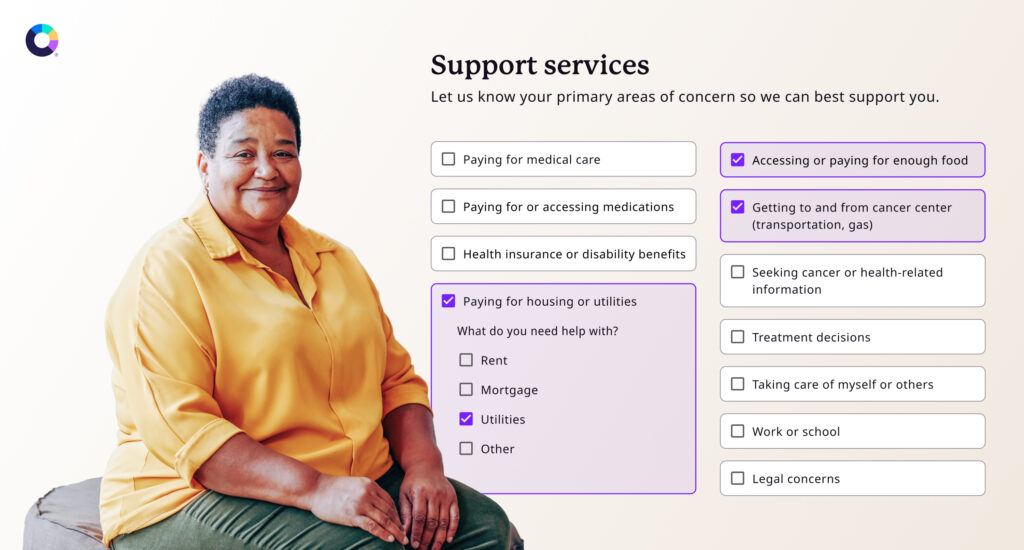Blog Post
What it takes to truly combat financial toxicity in cancer care
Color

Cancer’s financial toll can be just as devastating as the disease itself. It’s not just a short-term issue—financial hardships can persist for up to five years after patients enter remission, creating long-lasting economic challenges for the individual, caregivers, and their families. With employers insuring over 50% of the U.S. population, they have a significant role to play in alleviating this burden. Financial toxicity remains one of the “last taboos” in discussions of cancer, but employers are uniquely positioned to help address it. In this blog, we’ll explore cancer’s far-reaching impact and share how Color is taking meaningful steps to mitigate the financial strain on employees and their families.
When someone is experiencing a cancer diagnosis, acute financial challenges begin immediately– as if coping with the emotional and physical strain of cancer isn’t enough, those undergoing treatment are hit with skyrocketing costs. Cancer survivors report significantly higher out-of-pocket expenses compared to those who haven’t had cancer, with some paying over 20% of their annual income on medical care alone. Unfortunately, these costs don’t end when treatment does. Over a third of survivors continue to face cancer-related debt for at least three years post-treatment.
The working-age population is hit especially hard. Nearly three-quarters of cancer patients aged 35-44 reported falling behind on healthcare bills, with many depleting their savings to cover treatment. Around 28% of these individuals use most or all of their life savings, and many are forced to borrow from family, take out loans, or accumulate credit card debt.
The hidden costs of cancer can be overwhelming, quietly piling up alongside the emotional and physical toll of the disease. While some supplies are covered by insurance or financial-assistance programs, many essential items remain difficult to access or are not covered at all. These include transportation and lodging for treatment, nutritional supplements, additional childcare, and recovery supplies like specialized mattresses, wheelchairs, or compression garments. Patients may also need items to manage side effects, such as incontinence supplies, wound care, or remedies for nausea like emesis bags and hydration solutions. These expenses don’t just affect the patient—they also create financial strain for caregivers and family members who support them. Though these costs may seem minor individually, they steadily accumulate, placing a significant burden on everyone involved in the cancer journey.
But the financial strain goes beyond just the numbers—it directly impacts a person’s quality of life. Studies into financial toxicity reveal that people grappling with the economic fallout of cancer often experience more symptoms, more pain, and a lower overall quality of life. In fact, some survivors report that financial toxicity is more debilitating than physical, emotional, or even social challenges.
And financial strain can ultimately lead to negative impacts on a person’s health outcomes. One major implication is that it forces people to delay or forgo care. Approximately 10% of cancer survivors report skipping medical appointments or prescriptions due to costs. This disproportionately affects lower-income individuals and compounds health inequities. These realities underscore the urgent need to alleviate the economic burden cancer places on employees, members, and their caregivers and families. Addressing this financial strain is critical not only for improving health outcomes but also for reducing the inequities that deepen when access to care is limited by cost.
Real Solutions to Relieve the Financial Strain of Cancer

To combat financial toxicity and improve accessibility of cancer care, Color designed a first-of-its-kind Care Wallet, an employer-sponsored, cancer-specific Health Reimbursement Account (HRA) created to ease the burden of unavoidable out-of-pocket costs. The program includes:
- A flexible financial platform that allows members to manage and get reimbursed for their cancer-related expenses. The lower out-of-pocket costs on a range of services, including medications, imaging, supplies, and other supportive care associated with their cancer treatment. The Wallet is set-up as a HRA funded by the sponsoring employer or organization, that helps employees cover eligible healthcare expenses.
- Access to Color care advocates and financial resources to help members manage their healthcare spending efficiently, get answers to their questions, and enroll in other financial assistance programs
Color’s innovative model is designed to improve care outcomes, reduce stress and get people back to work faster and healthier by addressing the significant hidden costs associated with cancer that result in financial hardship, delayed care, poorer outcomes and oftentimes higher medical expenses down the line.
Financial toxicity is often overlooked in discussions of cancer, but addressing it is essential to improving outcomes and reducing the burden on employees and their families. Employers have a unique opportunity to help mitigate these costs and provide crucial support. To learn more about how you can assist your employees in managing cancer-related expenses, visit color.com or contact us at learnmore@color.com.


